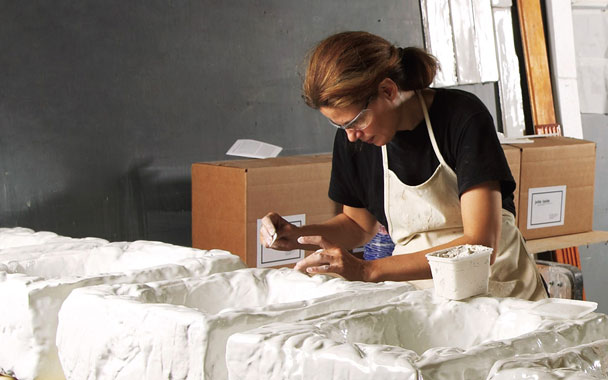When people talk about “flipping” houses, they usually mean buying real estate at a low price, giving the property a quick polish of renovation, and then selling at a profit. In her newest creation, however, New York City-based conceptual artist and chef Mary Ellen Carroll is literally flipping a Texas home around 180 degrees. In the process, she’s challenging assumptions about every aspect of domestic architecture—that’s everything and the kitchen sink. Carroll’s topsy-turvy project is being realized in Houston, she explains, because it is the largest metropolitan area in America that doesn’t have a formal zoning code for residences.
In a neighborhood called Sharpstown, she purchased a three-bedroom, 1,200-square-foot tract house (built in 1954) that structural engineers, following her instructions, will soon lift and spin halfway around, before returning it to its foundation and reconnecting all systems. The result, she says, will “reprogram” the structure from a residential building to a commercial or public-use space. “Everything I do is about questioning,” Carroll explains. “In Sharpstown, I’m looking at decisions related to design and urban planning. What is front? What is back? What are the invisible processes that impose consistencies in how people live?”
Not content to simply flip the house, Carroll envisioned ways to deconstruct its plumbing, too. For help with this, she turned to the Kohler Company in Wisconsin, the nation’s largest manufacturer of plumbing materials. Since 1974, Kohler has operated Arts/Industry, an unusual program that invites artists to experiment with the company’s facilities and industrial technologies. “We try to select artists doing extraordinary work, who will benefit from exposure to the factory and create new ways of thinking among our factory associates,” says Ruth Kohler, director of the John Michael Kohler Arts Center, which administers Arts/Industry. “We were intrigued by Mary Ellen’s mind and the conceptual nature of her work, particularly when we learned about the house in Texas.”
Carroll, 46, who regularly exhibits her work at galleries and institutions around the world, from the Whitney Museum in New York to the Institute of Contemporary Arts in London, is a recipient of both Guggenheim and Rockefeller Foundation fellowships. Whether her creations involve crashing a 1985 Buick Riviera into Munich’s Museum für Völkerkunde or walking out of her apartment door penniless with only her passport and the clothes on her back for a six-week visit to Argentina, she prides herself on not having a signature style.
On the contrary, she’s equally comfortable creating with neon, photography, ceramics, or food—the last in an ongoing series of performance pieces she calls “itinerant gastronomy,” in which she and her collaborator, Donna Wingate, cook exceedingly elaborate meals in inhospitable settings. (When was the last time you tried to deep-fry brioche donuts and serve them with chestnut purée or make veal sausage from scratch while perched on the Goethals Bridge, between Staten Island and New Jersey?) If there’s any consistency to her oeuvre, it’s that her creations all share a certain degree of theatricality and tricksterism and are conceived to frustrate easy assumptions about what constitutes a work of art. Carroll demystifies her sense of conceptual art by likening it to cooking. “A really great recipe is still great, whether or not the dish is ever prepared,” she says. “My exploration tends to be less about representation, more about language.”



 Pinterest
Pinterest






